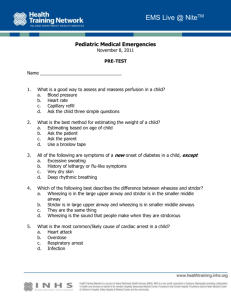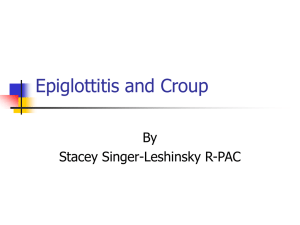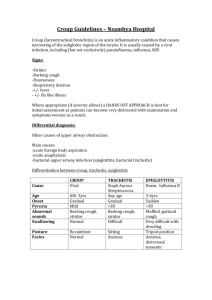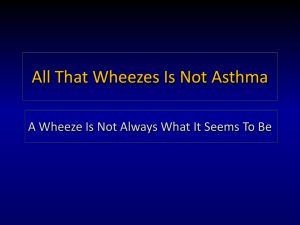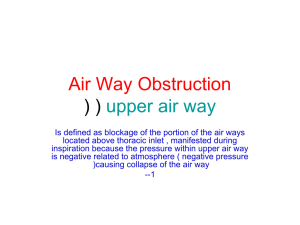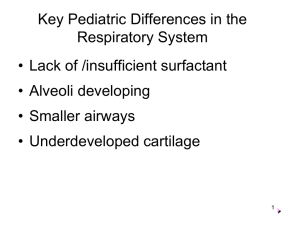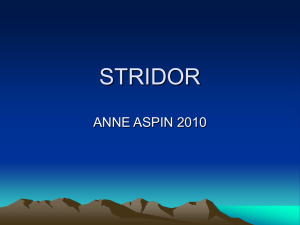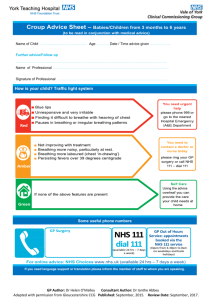Croup/Stridor
advertisement
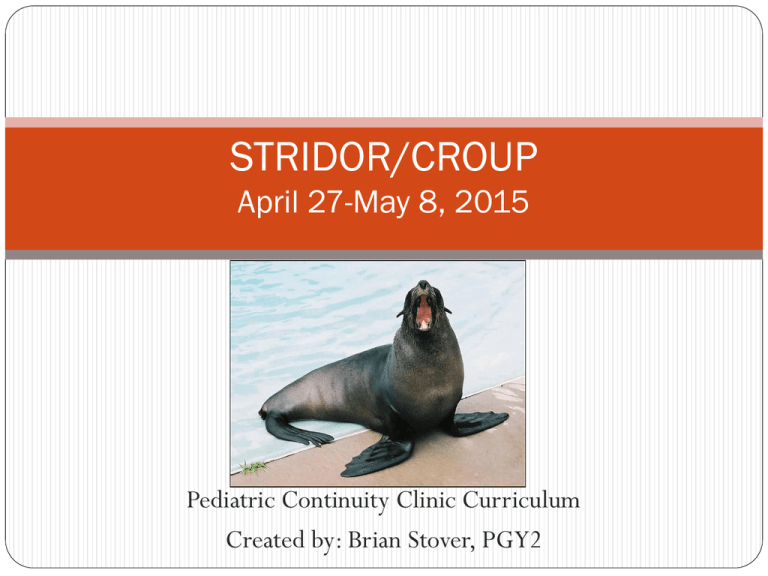
STRIDOR/CROUP April 27-May 8, 2015 Pediatric Continuity Clinic Curriculum Created by: Brian Stover, PGY2 Objectives Describe the presentation of croup Discuss the different severities Review treatments Understand that other things cause stridor Case #1 A 2 year old boy is brought to your office for a bad cough and “wheezing.” Mom reports that he had several days of a runny nose, low grade fevers, and congestion. Last night, she says he started having a “barking” cough, and had “wheezing when he breathed in.” His wheezing sound and breathing seemed to improve when she brought him outside. What does this child likely have based on this description? What virus usually causes this? What factors are associated with increased severity? Laryngotracheitis (Croup) Children 6 months to 36 months Subglottic narrowing/swelling of trachea Stridor worsened by agitation, barking/seal-like cough, +/- increased WOB Most commonly caused by Parainfluenza, but less commonly: RSV, adenovirus, measles, influenza Factors Associated with Severity Sudden onset of symptoms Rapidly progressing symptoms Previous history of croup Underlying airway abnormality Neuromuscular disorders or other conditions that predispose to respiratory failure Westley Croup Score Level of consciousness: Normal, 0; Disoriented, +5 Cyanosis: None, 0; with agitation, +4; at rest, +5 Stridor: None, 0; with agitation, +1; at rest, +2 Air entry: Normal, 0; decreased, +1; at rest, +2 Retractions: None, 0; mild, +1; moderate, +2; severe, +3 Mild: ≤2; Moderate: 3-7; Severe: ≥8 Case #2 When you begin to examine the child from the previous case, you notice that he is having loud stridor and moderate retractions. The stridor does not go away at rest, and the child looks uncomfortable. Pulse ox shows saturations of 90%. What treatment can be done immediately for this child? Does treatment differ depending on severity? Mild Croup Treatment Home treatment: Shower steam Cool night air Humidifiers Warm fluids Outpatient treatment: Oral dexamethasone 0.6mg/kg (max 10mg) – single dose Moderate to Severe Treatment In addition to previous treatments: Pulse ox Humidified oxygen if hypoxic Racemic epinephrine – nebulizer over 15 minutes, repeat as necessary Budesonide neb (2mg) can be used if no dexamethasone Discharge/Home Criteria No stridor at rest Normal pulse ox Good air movement Normal color and level of consciousness Tolerating PO Case #3 A mom brings in her 6 month old girl for a well child check. She notes that her baby girl has always had a “wheezing” sound when breathing in, that seems to get louder every time she has a cold. She says the sound improves when she is laying on her stomach, and worse on her back. However, she says she always seems comfortable while breathing, and has always fed well. Other than croup, what is in your differential for stridor in a child? What tests could you perform on this child? Differential of Stridor in Children Acute Epiglottitis – less common with Hib vaccines. Rapid, high fevers, toxic appearing. Sitting up and drooling. Rarely cough. Peritonsillar/retropharyngeal abscess – Drooling and neck extension. Cough usually absent. Foreign Body – History of sudden choking followed by upper airway symptoms. Can be hoarse with barking cough/stridor. Differential of Stridor in Children Allergic reaction – rapid onset. No preceding fevers/URI symptoms. +/- lip/tongue swelling, urticaria, dysphagia Upper airway injury – History of smoke/thermal/chemical burns; no fevers or viral prodrome Upper airway anomalies – Chronic course: laryngomalacia, laryngeal webs, vocal cord paralysis, subglottic stenosis Guillan-Barre – laryngeal nerve involvement Bronchogenic cyst – compressing airway Possible Tests CBC or RVP – not usually performed in croup, can help identify infectious process Radiography – Neck films can show abscess (retropharyngeal space w/air-fluid levels) vs croup (steeple sign) vs epiglottitis (thumb sign); not usually performed if croup suspected Laryngoscopy or nasopharyngoscopy to identify airway abnormalities and severity Steeple Sign PREP Question 238 (2013) You are working in the emergency department when a mother brings in her 9-month-old daughter for difficulty breathing that began several hours ago. She describes nasal congestion and mild subjective fever over the last 2 days but says that she noticed “noisy breathing” this morning. The girl’s oral intake has been adequate. Findings on physical examination reveal a respiratory rate of 40 breaths/min, a heart rate of 120 beats/min, and a temperature of 38.3°C. She is alert and interactive. Nasal congestion and audible inspiratory stridor are noted, and the stridor worsens with crying. Her lung sounds are clear except for transmitted upper airway noise. Her mucous membranes are moist but she is not drooling. The remainder of the physical examination findings are normal. Of the following, the therapy that is MOST likely to provide benefit at this time is: A. inhaled albuterol B. inhaled helium-oxygen C. inhaled racemic epinephrine D. intravenous ceftriaxone E. intravenous fluids A. inhaled albuterol B. inhaled helium-oxygen C. inhaled racemic epinephrine D. intravenous ceftriaxone E. intravenous fluids PREP Question 212 (2015) A 1-year-old infant is brought to your office for evaluation. The parents state that the infant was “born with asthma.” He has been noted to have wheezing for the past year, wheezing once to multiple times a day. The wheezing is occasionally related to exertion and to a full feed. He has been prescribed 2 puffs of a short-acting β-agonist with a spacer for these episodes, but the parents do not use it consistently, as it seems to help him only when he has an underlying cold. He was noted to spit up when he was younger, but this has improved since he began ambulating. He has never had to seek urgent treatment for his wheezing and has never received treatment with steroids. His height and weight are at the 50th percentile. His physical examination is unremarkable and his lungs are clear on examination. Of the following, the MOST appropriate test to order is: A. allergy testing B. barium swallow C. echocardiogram D. pH probe E. sweat chloride A. allergy testing B. barium swallow C. echocardiogram D. pH probe E. sweat chloride References Cherry JD. “Croup.” N Engl J Med 2008; 358:384-391 Gilbert EG, Russell KE, Deskin RW. “Stridor in the infant and child. Assessment, Treatment.” AORN J 1993; Jul;58(1):23, 26-31 Boudewyns A et al. “Clinical Practice: An approach to stridor in infants and children.” Eur J Pediatr. 2010;169(2):135
